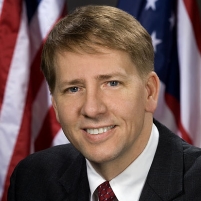Director of the Consumer Financial Protection Bureau: Who Is Richard Cordray
Monday, January 30, 2012

The new agency meant to protect consumers from the unfair, deceptive, or abusive practices of banks, credit unions, and other financial companies finally has a leader. Faced with a signed pledge by 44 Republican Senators to filibuster any nominee (only 41 are required to sustain a filibuster), President Barack Obama on January 4, 2012, recess-appointed former five-time Jeopardy! champion and Ohio State Attorney General Richard Cordray to be the first director of the Consumer Financial Protection Bureau (CFPB). Although some Republicans criticized the move because the Senate recess was extremely brief, judicial intervention against the nomination is unlikely, and Cordray is expected to serve through the end of the current Congressional term in late 2012. The Constitution (Article II, Section 2, paragraph 3) gives U.S. presidents the power to make recess appointments.
Born May 3, 1959, in Columbus, Ohio, the middle of three children of Frank and Ruth Cordray, Richard Cordray grew up in the nearby suburb of Grove City, Ohio, graduating from Grove City High School in 1977 as co-valedictorian of his class. He earned a B.A. in Legal & Political Theory at Michigan State University in 1981, an M.A. with first class honors in Economics from the University of Oxford in 1983, and a J.D. at the University of Chicago Law School, where he was editor-in-chief of the University of Chicago Law Review, in 1986.
Immediately after law school, Cordray took a series of judicial clerkships, first for Judge Robert Bork of the United States Court of Appeals for the District of Columbia Circuit (1986-1987), and then for Supreme Court Associate Justices Byron White (1987-1988) and Anthony Kennedy (1988 to 1989).
His clerkships completed, in 1989 Cordray was hired by the Cleveland-based law firm Jones Day to work in its Columbus office. He was elected to the Ohio State House of Representatives as a Democrat in 1990, but redistricting in 1991 led him to run for Congress in 1992. He was defeated by Republican Deborah Pryce, who went on to serve eight terms before retiring in 2009. In 1993 the state of Ohio created the office of state solicitor general to handle cases that are to be argued before the Ohio Supreme Court, the Sixth Circuit Court of Appeals, and the United States Supreme Court. Cordray, who had worked for a summer in the office of the United States Solicitor General, was Ohio’s first Solicitor, serving from September 1993 to November 1994, when Ohio Attorney General Lee Fisher was defeated by Betty Montgomery.
From 1995 to 2007, Cordray worked for the law firm of Kirkland & Ellis. He has argued seven cases before the United States Supreme Court, including by special appointment of both the Clinton and Bush Justice Departments. His most notable appearance was in Hanlon v. Berger (1999), in which he persuaded the Supreme Court that even though the police violated the Fourth Amendment by bringing the media along on a home search, they were entitled to qualified immunity because at the time of the search, the law was not clearly established.
In 1998 Cordray ran for Ohio State Attorney General against Republican Betty Montgomery, whose election in 1994 had spurred his resignation as solicitor general. Cordray lost that race, as well as a 2000 Democratic primary for U.S. Senate, although he won election in 2002 as Franklin County, Ohio, treasurer, winning re-election in 2004. He retained that post until his election in November 2006 as Ohio State Treasurer. As treasurer, Cordray brought back an economic development program that provides low-interest loan assistance to small businesses.
In 2008, following the resignation of Ohio Attorney General Marc Dann, Cordray ran for and won the remaining two years of Dann’s term. However, Cordray was defeated in his bid for a full term in 2010. During his two years as Attorney General, Cordray made headlines for his attempts to hold financial institutions accountable for their alleged misdeeds, especially for lawsuits against financial titans Bank of America and AIG.
Just a month after the defeat of his bid for re-election as Attorney General, Cordray was named to lead the enforcement arm of the CFPB by Elizabeth Warren, a special advisor to President Obama who was the best-known and most vocal advocate of the new agency. Cordray described the opportunity as a chance to keep “doing on a 50-state basis the things I cared most about as a state attorney general, with a more robust and a more comprehensive authority.”
From 1989 until 2002 Cordray was an adjunct professor at the Ohio State University College of Law.
A Democrat, Cordray has contributed $65,479 to Democratic candidates and causes since 1992, including $31,179 to the Ohio Democratic Party, $16,500 to the 21st Century Democrats PAC, $2,000 to John Kerry in 2004, $1,000 to Vice President Al Gore in 1999, and $250 to President Bill Clinton in 1996. Cordray and his wife Margaret,a professor at Capital University Law School in Columbus, have twin children, Danny and Holly. For her part, Margaret has contributed $16,500 to Democratic causes over the years as well.
-Matt Bewig
Former Ohio Attorney General to Head New Consumer Agency (by Binyamin Appelbaum, New York Times)
- Top Stories
- Unusual News
- Where is the Money Going?
- Controversies
- U.S. and the World
- Appointments and Resignations
- Latest News
- Trump to Stop Deportations If…
- Trump Denounces World Series
- What If China Invaded the United States?
- Donald Trump Has a Mental Health Problem and It Has a Name
- Trump Goes on Renaming Frenzy






Comments